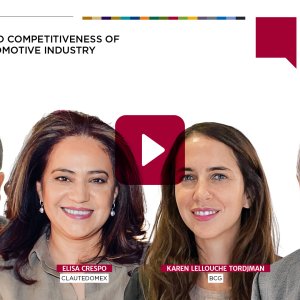Lessons Learned from the Pandemic

STORY INLINE POST
Q: How would you describe the role of automotive clusters amid the pandemic?
A: The situation we are living in is unprecedented and the need to have organizations like the automotive clusters was evident. In our case, we were the first liaison between the industry and the government, which is easier said than done. Behind a cluster, there is a mutual collaboration based on trust. Companies shared their concerns with us about the government’s response to the crisis. Due to the uncertainty, it was natural to create common agreements between industry and government as a sector that generates more than 20 percent of manufacturing GDP and more than 2 million direct and indirect jobs. In collaboration with INA, the clusters started to design all necessary health protocols to resume operations while honoring our commitments to our customers. Clusters are a strategic communication channel and we took an active role amid the pandemic.
Q: Manufacturing companies based in the State of Mexico took an active role in manufacturing medical equipment needed to face COVID-19. What was your role in that participation?
A: We are very proud of this project and our participation following the invitation from the federal government. We gathered a diverse group of companies, including German, Japanese, Spanish and Mexican players, to design components for the Ehécatl ventilator. Our role was to help coordinate all those efforts, together with a local research center, to deliver a finished product. As a result, we produced 52,400 components for respirator over a three-month period, apart from the two months we needed to ramp up the project. Today, some of these ventilators are being exported to other countries in Latin America. Our common goal was to save lives and although at first, it seemed like an uphill project, we accomplished it.
Q: What is the cluster’s strategy to strengthen the supply chain through new investments, taking into account USMCA’s new rules of origin?
A: We need to understand the needs of the companies that make up the Cluster and the Region and their commercial dynamics. In that sense, we have established permanent training to understand new USMCA rules of origin and the impact of each one of them on the configuration of the Regional Value Content (RVC) for core auto parts, those that are main and those that are complementary.
The Labor Value Content (LVC) is also related to the New Labor Reform, in that sense, we focus on the new relations between unions and companies, where the former take a more proactive role in a new organizational culture, with renewed values that keep jobs safe and companies running smoothly.
The second element was for suppliers to comply with a 10 percent increase in RVC. We are aware that companies must adapt to supply auto parts and other components regionally. Understanding how that percentage is structured is essential because it can be a great motivation for more local businesses to adopt production quality standards and certifications.
Another relevant aspect is compliance, which impacts the credibility of small and large operations alike. This means operating in a transparent work environment, including having all the paperwork and records in order, which in fact is one of our problems.
The sum of all these scenarios are actions that strengthen companies that are already in an optimal rhythm of competitiveness, which is ultimately what will allow all companies to face the demands of this treaty and attract new business and investments.
Q: Companies at the lower levels of the automotive supply chain are now vulnerable after the pandemic. How can they become more resistant?
A: For more than 100 years, the automotive industry has invested in R&D and a strong supply chain that can adapt quickly to change. COVID-19 has put employees’ resilience to the test. The only way to get ahead is to have a solid organizational structure that can respond by implementing the measures that adjust to the circumstances in times of crisis. Having a healthy economy is complex in these times, although it is necessary when the company has to make use of a line of financing. Naturally, some companies are vulnerable and will surely be transformed after this crisis. The government of the State of Mexico has provided incentives to companies in this situation.
Q: What role will the Automotive Cluster of the State of Mexico play in the new trends in the industry?
A: Today the Automotive Cluster of the State of Mexico is an essential articulator. In its work agenda, the main topics of the industry are outlined, including technological transformation and consumer trends. Sustainable development and mobility are also strengthened after the crisis. The younger generations are focused on sustainability and on having more efficient and intelligent mobility without needing to have a car, they are sending a very clear message of transformation and it is we, as an industry, who must adapt.
The region will be a strong player in the future. The new investments that we bring to the state are transferring high value, which means a high technological development characterized by advanced manufacturing, sustainable processes, and a high level of social responsibility. Talent is changing too. Soft skills are becoming more and more important to different departments of the organization. The sector works as a team and that is our main strength as a Cluster organization.








 By Alejandro Enríquez | Journalist and Industry Analyst -
Wed, 11/04/2020 - 06:00
By Alejandro Enríquez | Journalist and Industry Analyst -
Wed, 11/04/2020 - 06:00
















